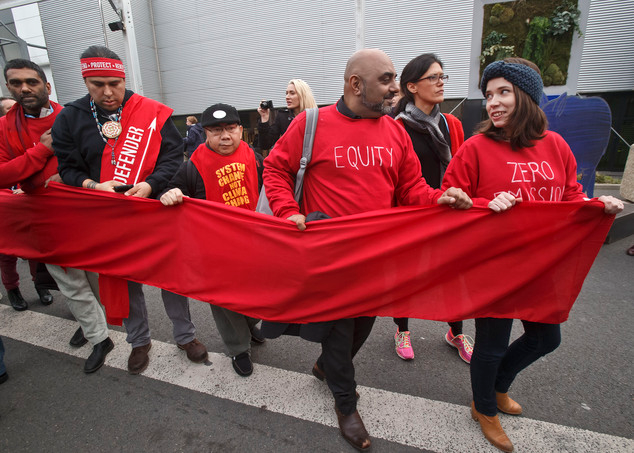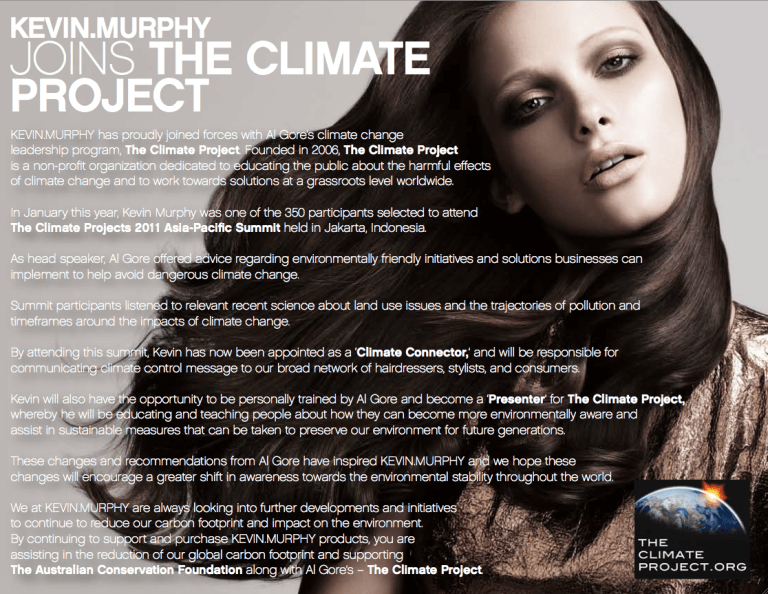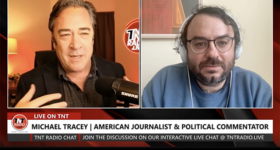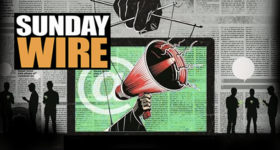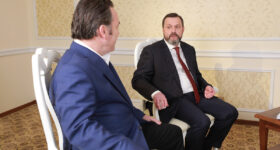Cory Morningstar & Forrest Palmer
Wrong Kind of Green
ACT TWO
“Establishing “heroes” and “villains” adds a moral element that will advance advocacy efforts.” — “Mobilizing Climate Action, To Paris and Beyond” retreat, March 4–6, 2015, New York
Here it is critical to highlight the “Mobilizing Climate Action, To Paris and Beyond” retreat held March 4–6, 2015, in Tarrytown, New York. As it is here that the hierarchy is laid bare and cannot be contested. The organizer of the retreat was the United Nations [9] with the retreat itself being financially facilitated by foundations (in this instance, the Clarmondial Foundation and The Stanley Foundation).
The congregation consists of numerous participants that all play a vital role: corporate financiers that rule the corridors of power by way of their purse strings, public relations and media, and the institutions and NGOs that reside at the helm of the socially influential non-profit industrial complex:
The United Nations, World Bank, Leonardo DiCaprio Foundation, We Mean Business (represented by co-founder Callum Grieve [10]), 350.org (represented by co-founder Jamie Henn) Upworthy (co-founded by Avaaz co-founder Eli Pariser), Avaaz, Here Now (Purpose, sister for-profit arm of Avaaz) World Economic Forum, GCCA (TckTckTck), World Business Council for Sustainable Development (chaired by Unilever CEO Paul Polman), Greenpeace, Unilever, and The Climate Reality Project (founded by Al Gore, co-founder of Generation Investment).
Mobilizing Climate Action, To Paris and Beyond retreat participants:
- Emad Adly, General Coordinator, Arab Network for Environment and Development
- Susan Alzner, Officer in Charge, Non-Governmental Liaison Service, United Nations
- Robert Bisset, Senior Communications Officer, Climate Change, The World Bank
- Roberto Borrero, UN Programs Coordinator, International Indian Treaty Council
- Karl Burkart, Leonardo DiCaprio Foundation
- Patty Carnevale, Senior Account Strategist, Upworthy
- Joel Finkelstein, Communications, Climate Advisers
- Nick Gaylord, Data Scientist, Idibon
- Rhys Gerholdt, Communications Manager, Climate and Energy Program, World Resources Institute
- Callum Grieve, Director of Communications, We Mean Business
- Michael Hanley, Editorial Director, World Economic Forum
- Fletcher Harper, Executive Director, GreenFaith
- Jamie Henn, Strategy and Communications Director and Co-Founder, 350.org
- Antonio Hill, Executive Director, Global Call for Climate Action
- Wael Hmaidan, Executive Director, Climate Action Network
- Kathy Jetnil-Kijiner, College of the Marshall Islands, Co-Founder, Jo-Jikum
- Ruth Jones, Head of Leadership Programme, The Climate Group
- Iain Keith, Campaign Director, Avaaz.org
- Amy Keller, Strategic Partnerships, Live Earth
- Ann Kobia, Advocacy Team, Secretariat, Pan African Climate Justice Alliance
- Kate Lappin, Regional Coordinator, Asia Pacific Forum on Women, Law and Development
- Carina Larsfälten, Managing Director, Global Policy and Strategic Partnerships, World Business Council for Sustainable Development
- Patricia Lerner, Senior Political Advisor, Greenpeace International
- Marie L’Hostis, Global Hub Coordinator, action/2015
- Thomas Lingard, Climate Advocacy and Sustainability Strategy Director, Unilever
- Tracy Mann, Consultant, MG Limited, and Project Director, Climate Wise Women
- Michael Mathres, Director, World Climate Ltd.
- Nelson Muffuh, Head of Outreach and Stakeholder Engagement, Post-2015 Development Planning Team, United Nations
- Margaret Novicki, Chief, Communications Campaigns Service, Department of Public Information, United Nations
- Nicholas Nuttall, Coordinator, Communications and Outreach, United Nations Framework Convention on Climate Change
- Jonathan Rich, President, JCR Communications
- Mila Rosenthal, Director of Communications, Bureau of External Relations and Advocacy, United Nations Development Programme
- Naysán Sahba, Director of the Division of Communications and Public Information, Office of the Executive Director, United Nations Environment Programme
- Peter Sargent, Campaigns Director, The Climate Reality Project
- Dan Shepard, Information Officer, Development Section, Department of Public Information, United Nations
- Robert Skinner, Executive Director, New York Office Operations and UN Relations, United Nations Foundation
- Sean Southey, Chief Executive Officer, PCI Media Impact
- João Talocchi, Campaign Director, Here Now
- Denise Young, Head of Communications, International Council for Science
- Stanley Foundation Staff [10]
Par for the course, the report includes the standard disclaimer: “Affiliations are listed for identification purposes only. Participants attended as individuals rather than as representatives of their governments or organizations.” This rhetoric is standard across most (if not all) boards that serve non-profit industrial complex. It is best understood as protectionist rhetoric. In reality, participants are absolutely representative of their governments or organizations. Otherwise, they would not have been chosen for, nor would they retain, these lucrative positions.
The purpose of this retreat was preparations for COP21, Paris. 2015 was chosen by the elites as the year to formally implement the necessary policies that would accelerate growth and create new markets. This will be achieved via the United Nations Sustainable Development Goals (Global Goals) under the guise of environmental protection and poverty eradication. From the report:
“Progress on climate change negotiations will take place within the context of broader efforts to establish a sustainable development agenda that addresses the differentiated needs of all countries and provides adequate financing for development projects that will enable growth without negatively impacting the environment and humanity. Therefore, efforts to address climate change will be enhanced by integrating them with the post-2015 development agenda also being negotiated this year.” [Source]
“The retreat will bring together communications and advocacy leaders to discuss how best to communicate about and inspire climate action as an accelerator of sustainable development in the context of the post-2015 agenda.” — Mobilizing Climate Action: To Paris and Beyond, Stanley Foundation Website
The “global goals” of the elites requires approx. 90 trillion dollars (90 trillion between now and 2030 that is required for planned mega-infrastructure projects, which is up from initial estimates of $60-70 trillion as of 2015). The Ceres (partner of the “We Mean Business” project, as well as a partner and advisor of the 350.org divestment scheme) “Clean Trillion” campaign “encourages investors, companies and policymakers to invest an additional $1 trillion per year globally in low-carbon energy alone.” The development projects are contingent on furthering extractive industries (all of which are dependent on fossil fuels from cradle to grave). The most important items to note here are the following:
1) the “global goal” to unleash developments projects that “enable growth without negatively impacting the environment and humanity” is a proven and irrefutable oxymoron, and
2) most critically, the main pillar of the “new economy (“global goals”) is the financialization of nature. That is, privatizing and assigning monetary value to all services on the planet that nature provides. Make no mistake, the financialization of nature is the unspoken, yet absolute key goal of the United Nations (in servitude the oligarchy) that today is being implemented behind closed doors.
Paris is not the end point. It’s a launching pad”, said Robert C Orr, principal policy advisor to the UN secretary-general Ban Ki-moon.” — Paris Meet will be a Launching Pad: UN official, March 8, 2015
“Nick Henry, CEO of Climate Action, said: “Climate change not only presents the single largest threat to mankind, it also creates the greatest economic opportunity since the industrial revolution. ” — Businesses and Investors Pioneering the Green Economy Highlight Multi-trillion Dollar Opportunity in Tackling Climate Change, December 7, 2015
The emphasis at the retreat was the building of societal consensus for the Paris outcome by establishing new climate “leaders” and “subgroups”, the incorporating of “storytelling”, and the further targeting of youth, as identified in the highlights:
“Climate change messaging should be reframed and rebranded. Messages of despair ought to be transformed into scenarios for hope and opportunity, particularly in the context of sustainable development.”
“Increasing mobilization and amplification are critical leading up to COP21. This will include new media strategies as well as outreach to new audiences and advocates.”
“Identifying leaders of all kinds in their respective spheres of influence will heighten awareness for newly acknowledged subgroups of climate change actors as well as political leaders; storytelling will incorporate a personal, emotional element of climate change that has been missing from the narrative.”
“It is widely agreed that engaging youth is of central importance to encourage future constructive climate action—for the youth of today are the decision makers of tomorrow.”
For anyone who believes local grassroots groups are not prone to be influenced, led or even manipulated by international organizations, the following “broader approach” highlighted in the report demonstrates otherwise: participants acknowledged that the agreed upon broader approach “can then be tailored at the local level so that the varied campaigns are connected”.
To further the continuous targeting of youth, the retreat participants identified key targets “to deepen the pool of activists by mobilizing leaders across the world in their respective spheres of influence and reaching out to even more groups of stakeholders”. The two key “international actors” identified to achieve this goal were trade unions and public-private partnerships. [12]
One particular campaign strategy identified in the report was the shared aspiration to develop a “ribbon symbol” (“create a climate change symbol that is equally pervasive and can be used broadly across all public campaigns to escalate collaboration and solidarity.”) Here, one can recall the “Climate Ribbon Campaign” of the People’s Climate March and Cop21 Paris. Although the document identified blue as the sought colour for the ribbons, the end result was red as outlined in the 350.org “Redlines for Climate Actions Manual Draw the Line for Climate Justice” document. [13]
“Symbols are powerful, inspirational and instantly recognizable. When harnessed effectively by companies, symbols can have a strong impact on corporate culture, recruiting, morale and brand longevity.” — Forbes
“No matter what action you do, please also share your action on social media?so the rest of the world can see it. Take a photo or video and post on Twitter, Instagram or Facebook (if it’s on Facebook, please make sure it’s public) and then use make sure you add #D12 or #redlines. You can also send an email to [email protected]“
“We perceive, understand, and negotiate the world around us by investing meaning in all manner of signs and symbols.” — The History of Logos and Logo Design by Dan Redding
“As people interact with a symbol — whether brand, religious, or otherwise — it gets packed with meaning. It becomes a heuristic of what’s to come.” — Make Your Brand Iconic: The Power of Symbols in Branding, Sticky Branding website
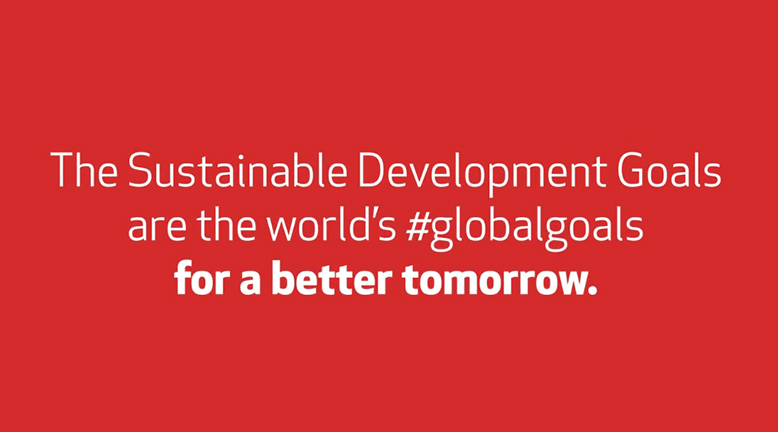
United Nations Development Programme, A Look at the Sustainable Development Goals, 2015
Other essential tasks as highlighted in the report are to “identify business leaders who are willing to take the spotlight and reveal their support for climate change efforts up to and beyond COP21”. This is more than simply greenwashing. Short-term, this is the growing strategy to bring corporate power into the fold of “activism”.
The Avaaz partner, Ben & Jerry’s, owned by Unilever and a client of Purpose, is a prime example of this mind-bending process. Long-term, as the financialization of nature is implemented at a global scale, financial markets and business will be assigned as the new “stewards of national natural capital.” Hence, the transformation (in appearance only) of corporations from psychopathic institutions into our future “stewards of nature” has already commenced.
Here, it is of special interest to note the role of media. Journalists are simply to be trained. From the report:
“Train media and establish a rapid response team: Spend time with media organizations to train them on climate change messaging.”
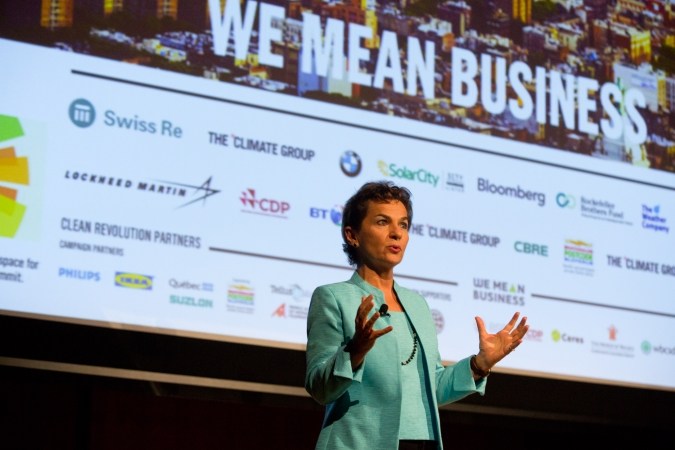
Christiana Figueres, Executive Secretary, UNFCCC at launch of ‘We Mean Business’ at the Climate Week NYC 2014
The report identifies specific language that can be utilized by all NGOs. Repetitive language has long been key to successful social engineering. Consider the “de facto slogan”, agreed upon by the participants: “together we can, together we must, together we will“. Examples of the agreed upon terminology have been utilized by the NGOs and can be found in the following excerpts:
“I believe that with clear leadership together we can, and we must, continue to deliver multilateral breakthroughs time after time after time,” — Christiana Figueres, July 18, 2016, former UN climate chief, B Team leader
“It will take all of us. But together, we can — and we will — blaze a bright path through this dark day.” — May Boeve 350, November 9, 2016
Here it is critical to reflect upon the “leadership void”, a concern highlighted by those in attendance at this retreat and their allies, such as The B Team. To this end, there are no limits on who or what the elite and market forces are prepared to exploit in order to fill the niches that will further advance their desired agendas.
As par for the course for the further expansion of industrial civilization, Indigenous People will, as always, be on the front lines of those most impacted by the United Nations’ Sustainable Development Goals (SDGs). Hence, in regard to the aforementioned need of the NPIC to “reach new audiences and advocates”, to have an Indigenous face as an exotic veneer to one’s brand is a marketing achievement of such grandeur, it is fetishized by those that comprise the non-profit industrial complex. An Indigenous face to brand/market the SDGs – is the ultimate acquisition.
Activism is the New Sex – But Sex Still Sells

Photography Dan Martensen, “Xiuhtezcati wears Jeans, belt and bracelets (worn throughout) model’s own.”
“That’s the crux of successful marketing today: activism is in. ‘Our activism is currently mediated by brands,’ says Will Fowler, creative director of Headspace. ‘Brands are allowing people to pat themselves on the back without them personally having to sacrifice anything.’” — Sex Doesn’t Sell Any More, Activism Does. And Don’t the Big Brands Know It, February 3, 2017
Today, selling “environmentalism” utilizes the same successful formula utilized to sell designer blue jeans decades ago – as well as the same formula used to promote white superiority in the mid-1800’s.
“This childish figure, outfitted in a short skirt, with pretty moccasins on its dainty feet and a single feather in its long, flowing hair, represents a quintessential, sexually undifferentiated Indian—although the bare breasts and the bow and arrows strewn along the ground reveal this to be a nonthreatening male Indian. The woman is pointing at a map in a book held open in her lap. Following her gaze, the Indian is also looking at the book, and his posture, more than the unreadable expression of his face, suggests that he is open to, if not exactly eager for, the instruction about to be dispensed.” — White Women’s Rights, evolution, woman’s rights, and civilizing missions, page 23
Consider the case of the 17-year-old Indigenous youth Xiuhtezcatl Martinez made famous by the media, who made his debut in the “environmental movement” at age six. Today, Martinez is the youth director of Earth Guardians, a worldwide conservation organization – an NGO which at COP21 shared the stage at the United Nations with international NGO “leaders” including Al Gore (The Climate Reality Project) and 350.org’s May Boeve. Martinez has been sought by, coddled and courted by those most powerful and influential including Barack Obama, Leonardo DiCaprio, The United Nations, Mark Rufallo, Bill McKibben, etc. etc.
At the tender age of 15, Martinez was photographed for a VICE feature (July 11, 2016), with images that deliberately seek to invoke a suggestive, hip prowess. One may recall a very contentious 1980 Calvin Klein ad featuring a 15-year old Brooke Shields (shot by photographer Richard Avedon). What was controversial in 1980 is today lost in a system where sexualisation is used to sell most everything including so-called environmentalism.
Jeans yesterday…
Faux environmentalism today – both in servitude to capital. The sexualization of children and teens is not so much problematic as it is sought, idolized, and even worshipped by a culture in decline. With almost four consecutive decades of social engineering and conditioning, this exploitation and sexualisation is not only of very little interest, it is rarely, if ever, noticed at all.
“His work has been featured on PBS, Showtime, National Geographic, Rolling Stones, Upworthy, The Guardian, Vogue, Bill Maher, Skavlan, CNN, MSNBC, HBO, VICE, and more. In 2013, Xiuhtezcatl received the 2013 United States Community Service Award from President Obama, and was the youngest of 24 national change-makers chosen to serve on the President’s youth council. He is the 2015 recipient of the Peace First Prize, recipient of the 2015 Nickelodeon Halo Award, 2016 Captain Planet Award and the 2016 Children’s Climate Prize in Sweden. Bill Mckibben of 350.org calls Xiuhtezcatl ‘an impressive spokesman for a viewpoint the world needs to hear.’” — Earth Guardians Website

“Viewing sexualized images tend to elicit a variety of sensations that lead one to making an association of possible pleasurable outcomes for him/herself.” (Adams 1916)
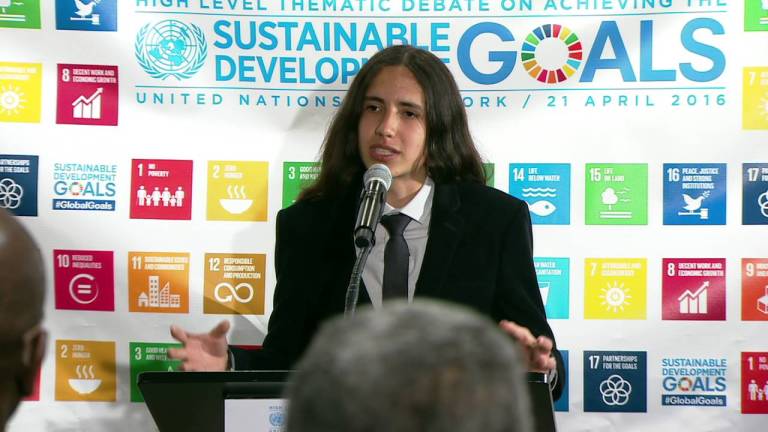
Xiuhtezcatl Roske-Martinez, Earth Guardians speaks at UN Climate Reception – 21 April 2016
“Now that you’ve been denied your former way of life, and can only play at being Indian, let me teach you some geography in accordance with our remapping of a wilderness that once was yours.” — White Women’s Rights, evolution, woman’s rights, and civilizing missions, page 23
Rebranding Capitalism. Above: The future is here: Corporations as the new “stewards of national natural capital.”
***
ACT ONE OF AVAAZ: THE PYGMALION VIRUS
For more information on AVAAZ: 21st Century Wire AVAAZ files
SUPPORT 21WIRE – SUBSCRIBE & BECOME A MEMBER @ 21WIRE.TV




